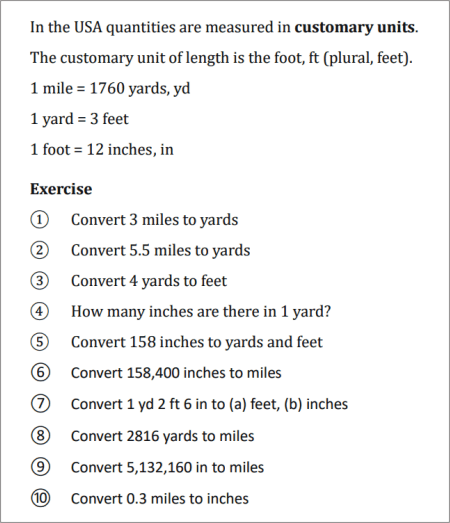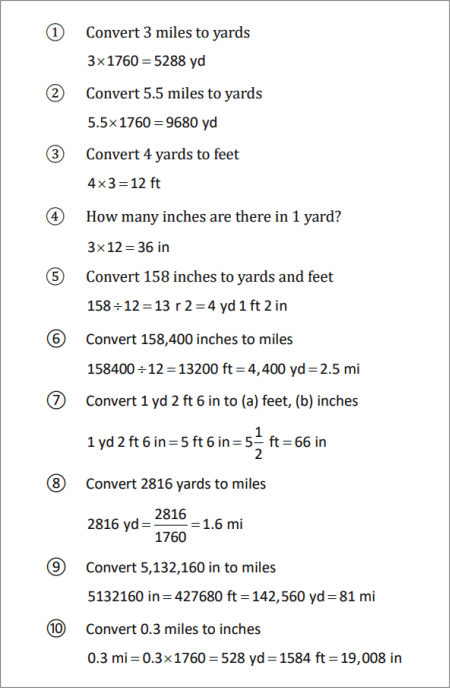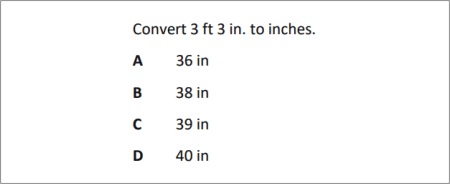|
Measurement |
|
|
|
To use the resources of this chapter you must first register |
|
|
CONTENTS |
|
|
ITEM |
|
TYPE |
|
NUMBER |
|
| Measuring quantities |
|
Workout |
|
13 slides |
|
| Measurement |
|
Library |
|
-1 questions |
|
|
|
Once you have registered, you can work through the slides one by one.
The workout comprises a series of sides that guide you systematically through the topic concept by concept, skill by skill. The slides may be used with or without the support of a tutor. The methodology is based on problem-solving that advances in logical succession by concept and difficulty. The student is presented with a problem or series of questions, and the next slide presents the fully-worked solution. To use the material you must sign-in or create an account.
blacksacademy.net comprises a complete course in mathematics with resources that are comprehensive.
|
|
|
|
SAMPLE FROM THE WORKOUT |
| Showing American English version |
SLIDE 1 - QUESTION 1 |
 |
|
SLIDE 2 - SOLUTION |
 |
|
|
SAMPLE FROM THE LIBRARY |
| Showing American English version |
QUESTION [difficulty 0.1] |
 |
|
SOLUTION |
 |
|
|
DEPENDENCIES |
|
|
|
|
CONCEPTS |
|
|
|
|
LEV. |
|
|
Units of length in metric system / customary units
|
|
434.1 |
|
|
Units of volume in metric system / customary units
|
|
434.3 |
|
|
SI - Systeme Internationale / USA system
|
|
434.5 |
|
|
Units of mass in metric system / customary units
|
|
434.7 |
|
|
Approximation by decimal places
|
|
434.9 |
|
|
Error interval, error bound
|
|
435.1 |
|
|
Upper and lower bound
|
|
435.1 |
|
|
|
|
RAW CONTENT OF THE WORKOUT |
|
| To make use of this chapter, please first register. Then you can work through the slides one by one. |
|
| What is provided here is the raw text of the workout. Most of the information is contained in the image files, which are not included with this text. The text may appear deceptively short. (The content overall of blacksacademy.net is vast.) Any in-line questions appear as a question mark [?]. This text is provided only as an indication of the overall quantity of material contained in the chapter. To use the material you must sign-in or create an account. |
|
| * |
|
|
SLIDE 1
In Britain and Europe quantities are measured in the metric system.
The metric unit of length is the metre, m
1 kilometre = 1000 metres 1 km = 1000 m
1 metre = 100 centimetres 1 m = 100 cm
1 centimetre = 10 millimetres 1 cm = 10 mm
Exercise
? Convert 3 km to metres
? Convert 5.5 km to metres
? Convert 4 m to cm
? How many millimetres are there in 1 metre?
? Convert 158 cm to metres
? Convert 3251 mm to metres
? Convert 1 m 10 cm 4 mm to (a) metres, (b) millimetres
? Convert 2139 metres to kilometres
? Convert 435378 cm to kilometres
? Convert 0.3 km to centimetres
SLIDE 2
?
?
?
? 1000mm
?
?
?
?
?
?
SLIDE 1B
In the USA quantities are measured in customary units.
The customary unit of length is the foot, ft (plural, feet).
1 mile = 1760 yards, yd
1 yard = 3 feet
1 foot = 12 inches , in
Exercise
? Convert 3 miles to yards
? Convert 5.5 miles to yards
? Convert 4 yards to feet
? How many inches are there in 1 yard?
? Convert 158 inches to yards and feet
? Convert 158,400 inches to miles
? Convert 1 yd 2 ft 6 in to (a) feet, (b) inches
? Convert 2816 yards to miles
? Convert 5,132,160 in to miles
? Convert 0.3 miles to inches
SLIDE 2B
? Convert 3 miles to yards
? Convert 5.5 miles to yards
? Convert 4 yards to feet
? How many inches are there in 1 yard?
? Convert 158 inches to yards and feet
? Convert 158,400 inches to miles
? Convert 1 yd 2 ft 6 in to (a) feet, (b) inches
? Convert 2816 yards to miles
? Convert 5,132,160 in to miles
? Convert 0.3 miles to inches
SLIDE 3
The metric unit of volume is the litre, L
1 litre is 1000 millilitres, 1000 mL
Exercise
? Convert 2 L to millilitres
? Convert 4.75 L to millilitres
? Convert 1625 mL to litres
? A one litre measuring cylinder contains 250 mL of liquid. What fraction of the cylinder is full?
? Convert 750 mL to litres
? To make a squash we need to add 300 mL of juice to 1 L of mineral water. What will be the volume of the drink in litres?
SLIDE 4
?
?
?
? A one litre measuring cylinder contains 250 mL of liquid. What fraction of the cylinder is full?
full
?
? To make a squash we need to add 300 mL of juice to 1 L of mineral water. What will be the volume of the drink in litres?
SLIDE 3B
Customary units of volume
Exercise
? Convert 2 gallons to pints
? Convert 4.75 gallons to pints
? Convert 256 fluid ounces to gallons
? A one pint measuring cylinder contains 1 gill of liquid. What fraction of the cylinder is full?
? Convert 12.5 gal to fluid ounces.
? To make a squash we need to add 4 fl. oz of juice to 1 gal of mineral water. What will be the volume of the drink in pints?
SLIDE 4B
? Convert 2 gallons to pints
? Convert 4.75 gallons to pints
? Convert 256 fluid ounces to gallons
? A one pint measuring cylinder contains 1 gill of liquid. What fraction of the cylinder is full?
? Convert 12.5 gal to fluid ounces.
? To make a squash we need to add 4 fl. oz of juice to 1 gal of mineral water. What will be the volume of the drink in pints?
SLIDE 5
The units of volume, litre (L) and millilitre (mL) are used in everyday life. For example, when you are at a petrol station, you buy petrol in litres.
In science volumes are measured in SI units.
SI stands for “Système Internationale”, which is French for “International System”.
1 decimetre, dm, is of a metre = 10 cm = 0.1 m
1 centimetre, cm, is of a metre = 1 cm = 0.01 m
In the SI system the units of volume are the cubic decimetre, , and the cubic centimetre, .
These are exact conversions.
Exercise
? Convert 2.3 L to
? Convert 395 mL to
? Convert 1.75 L to
? In an experiment, 475 of water is added to 250 of alcohol. What is the combined volume in ?
? Convert 2.55 to
SLIDE 6
?
?
? Convert 1.75 L to
? In an experiment, 475 of water is added to 250 of alcohol. What is the combined volume in ?
?
The unit is also abbreviated as 1 cc (cubic centimetre)
SLIDE 5B
Customary unit of mass
? How many ounces are there in one US tone?
? Convert 1 t 2 cwt 55 lb to pounds
? Convert 1 t 941 lb to pounds
? In an experiment 12 ounces of sand were added to 8 ounces of cement. What was the combined weight of the mixture in pounds?
? If 1 stone (st) is 14 pounds, convert 8 st 5 lb 8 oz to pounds.
SLIDE 6b
? How many ounces are there in one US ton?
? Convert 1 t 2 cwt 55 lb to pounds
? Convert 1 t 941 lb to pounds
? In an experiment 12 ounces of sand were added to 8 ounces of cement. What was the combined weight of the mixture in pounds?
? If 1 stone (st) is 14 pounds, convert 8 st 5 lb 8 oz to pounds.
SLIDE 7
The metric unit of mass is the kilogram, kg
1 kilogram is 1000 grams 1 kg = 1000 g
1 metric tonne is 1000 kilograms 1 t = 1000 kg
? What is 13.45 kg in (a) tonnes, (b) grams?
? Subtract 232 g from 1.25 kg
? At a quarry a rock with mass 15 kg was split into 100 pieces of equal mass. What was the mass of each piece in grams?
? A crate with mass 300 kg fell off the back of a lorry. If the lorry weighed 5.75 tonnes before the accident, what was the weight of the lorry in kg after the crate fell off?
? When copper is roasted in air it gains oxygen. In an experiment the mass of copper foil before roasting was 3.795 g. After it was roasted it gained mass and was 4.012 g. What was the gain of mass?
? At a chocolate factory 3.75 kg of pure chocolate was added to 4.15 kg of sugar and 12.85 kg of milk. This was cooked together and divided into 100 bars. What was the mass of each bar in grams?
SLIDE 8
? What is 13.45 kg in (a) tonnes, (b) grams?
? Subtract 232 g from 1.25 kg
? At a quarry a rock with mass 15 kg was split into 100 pieces of equal mass. What was the mass of each piece in grams?
? A crate with mass 300 kg fell off the back of a lorry. If the lorry weighed 5.75 tonnes before the accident, what was the weight of the lorry in kg after the crate fell off?
? When copper is roasted in air it gains oxygen. In an experiment the mass of copper foil before roasting was 3.795 g. After it was roasted it gained mass and was 4.012 g. What was the gain of mass?
? At a chocolate factory 3.75 kg of pure chocolate was added to 4.15 kg of sugar and 12.85 kg of milk. This was cooked together and divided into 100 bars. What was the mass of each bar in grams?
20.75 kg = 20750 g
SLIDE 7B
? What is 13.45 lb in (a) hundredweight, (b) ounces?
? Subtract 232 oz from 20 lb. Give your answer in pounds.
? At a quarry a rock with mass 15 cwt was split into 100 pieces of equal mass. What was the mass of each piece in pounds?
? A crate with mass 300 lb fell off the back of a lorry. If the lorry weighed 5.75 ton before the accident, what was the weight of the lorry in ton after the crate fell off?
? At a chocolate factory 3.75 lb of pure chocolate was added to 4.15 lb of sugar and 12.85 lb of milk. This was cooked together and divided into 100 bars. What was the mass of each bar in ounces?
SLIDE 8B
? What is 13.45 lb in (a) hundredweight, (b) ounces?
? Subtract 232 oz from 20 lb. Give your answer in pounds.
? At a quarry a rock with mass 15 cwt was split into 100 pieces of equal mass. What was the mass of each piece in pounds?
? A crate with mass 300 lb fell off the back of a lorry. If the lorry weighed 5.75 ton before the accident, what was the weight of the lorry in ton after the crate fell off?
? At a chocolate factory 3.75 lb of pure chocolate was added to 4.15 lb of sugar and 12.85 lb of milk. This was cooked together and divided into 100 bars. What was the mass of each bar in ounces?
SLIDE 9
Approximation
When approximating by decimal places we count the digits following the decimal point.
When approximating we use the rule that any digit 5 or greater is rounded up, and any digit 4 or less is rounded down.
The approximation is given to the number of decimal places (d.p.).
Example
21.371 = 21.37 (2 d.p.) = 21.4 (1 d.p.)
Exercise
Write down the following correct to the number of decimal places stated:
? 45.482 to (a) 2 d.p. (b) 1 d.p.
? 0.008518 to (a) 5 d.p. (b) 3 d.p. (c) 2 d.p.
? 0.008518 to (a) 5 d.p. (b) 3 d.p. (c) 2 d.p.
? 164.2618 to (a) 3 d.p. (b) 2 d.p. (c) 1 d.p.
? 16.5454 to (a) 3 d.p. (b) 2 d.p. (c) 1 d.p. (d) 0 d.p.
SLIDE 10
? 45.482 = 45.48 (2 d.p.) = 45.5 (1 d.p.)
? 0.008518 = 0.00852 (5 d.p.) = 0.009 (3 d.p.)
= 0.01 (2 d.p.)
? 5.9702 = 5.970 (3 d.p.) = 5.97 (2 d.p.)
? 164.2618 = 164.262 (3 d.p.) = 164.26 (2 d.p.)
= 164.3 (1 d.p.)
? 16.5454 = 16.545 (3 d.p.) = 16.55 (2 d.p.)
= 16.5 (1 d.p.) = 17 (0 d.p.)
SLIDE 11
We measure quantities with instruments.
Example.
A ruler is used to measure the length of a piece of paper, which is found to be 8.6 cm to the nearest mm. What is the error interval for the length of paper?
Solution
The ruler is only accurate to the nearest 1/10 of a centimetre.
The actual length of the paper could be anywhere between 8.55 and 8.65 cm; it is 8.6 cm to the nearest 1/10 of cm (nearest 1 mm).
The upper bound is 8.65 and the lower bound is 8.55
The error interval is cm length cm
Here we use inequalities to express the error bound. Since in rounding an approximation a 5 rounds up, the lower bound is 8.55 = length. We say, “the length is greater than or equal to 8.55”. The upper bound is length 8.65, “the length is less than 8.65”, because if it is equal to 8.65 it rounds up instead to 8.7.
SLIDE 11B
We measure quantities with instruments.
Example.
A ruler is used to measure the length of a piece of paper, which is found to be 8.6 in to the nearest 0.1 in. What is the error interval for the length of paper?
Solution
The ruler is only accurate to the nearest 1/10 of a centimetre.
The actual length of the paper could be anywhere between 8.55 and 8.65 in; it is 8.6 in to the nearest 1/10 of in (nearest 1 mm).
The upper bound is 8.65 and the lower bound is 8.55
The error interval is in length in
Here we use inequalities to express the error bound. Since in rounding an approximation a 5 rounds up, the lower bound is 8.55 = length. We say, “the length is greater than or equal to 8.55”. The upper bound is length < 8.65, “the length is less than 8.65”, because if it is equal to 8.65 it rounds up instead to 8.7.
SLIDE 12
Find the error bounds for the following measurements
? Mass of cheese is 10.8 kg to the nearest 0.1 kg
? Volume of milk is 4.2 L to the nearest 0.1 L
? Distance to Bristol is 3.2 miles to the nearest 0.1 mile
SLIDE 13
? Mass of cheese is 10.8 kg to the nearest 0.1 kg
mass of cheese kg
? Volume of milk is 4.2 L to the nearest 0.1 L
volume of milk L
? Distance to Bristol is 3.2 miles to the nearest 0.1 mile
distance to Bristol m
SLIDE 12B
Find the error bounds for the following measurements
? Mass of cheese is 10.8 lb to the nearest 0.1 lb
? Volume of milk is 4.2 pt to the nearest 0.1 pt
? Distance to Bristol is 3.2 miles to the nearest 0.1 mile
SLIDE 13B
? Mass of cheese is 10.8 kg to the nearest 0.1 kg
? Volume of milk is 4.2 L to the nearest 0.1 L
? Distance to Bristol is 3.2 miles to the nearest 0.1 mile
distance to Bristol m
|
|